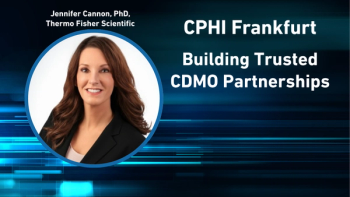
Outsourcing Perspectives from John S. Ross of Metrics Contract Services
John S. Ross, executive vice president at Metrics Contract Services, provided commentary on the evolving role of contract services in solid/semi-solid dosage development and manufacturing.
Technical/Scientific Trends
Solid/semi-solid dosage development and manufacturing
PharmTech: What emerging technologies or practices do drug sponsors expect your organization to provide?
John S. Ross: Drug sponsors increasingly are looking to solid oral dose formulation development experts for help maximizing the effective availability of API by using sophisticated modified release technologies, as well as bioavailability improvement technologies suited for poorly soluble API. Through these technologies, formulation development scientists can develop products that deliver patient benefits such as reduced dosing frequency, an improved side effect profile and more consistent therapeutic effects. Drug sponsors also are looking to companies like Metrics Contract Services for early-stage strategies that allow them to streamline later stage needs, including commercial production.
PharmTech: What scientific or technical advances have positively or negatively impacted drug development processes in this market segment?
John S. Ross: Spray drying technologies have had a tremendously positive influence on formulation development. In addition to allowing scientists to render powder from a solution, spray drying can be useful for modifying particle sizes, agglomerating nanoparticles and microencapsulation, thus expanding the array of drug-delivery options available to scientists when working with a specific API.
PharmTech: Are you seeing shifts in demand for particular types of services? Please describe.
John S. Ross: As a whole, the pharmaceutical industry is seeing growth in the proportion of potent and cytotoxic API in the pipeline. At Metrics Contract Services, we met this challenge by custom-engineering a dedicated facility that provides total containment using hard-wall isolation technologies. Our multi-use, hard-wall isolators accommodate different pieces of processing equipment, allowing clients to select only those capabilities needed for particular projects. This ensures that we don’t have dedicated clean systems standing dormant, as a more traditional potent facility might experience. Our hard-wall containment systems are rated down to occupational exposure levels (OEL) of 30 nanograms per cubic meter of room air.
PharmTech: What pressing technical challenges have you seen in this market segment? What actions has your company taken to resolve the challenge? What actions does your company suggest?
John S. Ross: An increasing proportion of API is poorly soluble. In response, Metrics Contract Services offers its drug delivery technology called SUBA that involves co-processing poorly soluble API with a cellulosic enteric polymer. Co-processing with the enteric cellulosic polymer reduces particle size and hinders further re-crystallization of the API, allowing for a higher level of bioavailability in the small intestine. SUBA was developed by Mayne Pharma, the parent company of Metrics Contract Services. Mayne Pharma has a 30-year track record of innovating oral drug delivery systems, and their technologies have been successfully commercialized in numerous products marketed around the world. Along with SUBA, we developed an in-vitro analytical technique to test whether we’ve successfully achieved a sub-micron particle size distribution of the poorly soluble API. A drug sponsor wants to know right away whether SUBA technology even works for their API, so in-vitro testing allows us to determine that quickly before conducting expensive bio-equivalence trials.
Industry Trends
PharmTech: What regulatory changes have positively or negatively impacted drug development/manufacturing processes in this market segment?
John S. Ross: CDMOs continue to be challenged by the various standards for GMP processes at different developmental stages as established by different country’s regulatory authorities. It would be helpful to have more global consistency.
PharmTech: What business trends have positively or negatively impacted drug development/ manufacturing processes in this market segment?
John S. Ross: We’re seeing two trends that are positively affecting Metrics’ contract formulation development and manufacturing services. One, the number of virtual pharma companies is growing. Thanks to their business models, these companies are committed to working with outsourcing partners, especially when it involves potent and cytotoxic products. Two, drug sponsors are experiencing higher uncertainty with the ability of offshore markets to comply with GMP regulations, an uncertainty that’s been fueled in recent years due to high-profile lapses in drug product integrity. As a result, they are relying more upon domestic CDMOs that offer proven high-quality standards and more transparent operations.
PharmTech: What changes are you observing in the organization and operations of drug sponsors in this market segment?
John S. Ross: In addition to observing more virtual operations among drug sponsors, we see them involving more consultants who are charged with providing regulatory and CMC guidance. Drug sponsors also are relying more upon domestic CDMOs for quality outsourcing.
PharmTech: How has Quality by Design influenced a drug sponsor’s expectations of suppliers?
John S. Ross: The International Conference on Harmonisation has embraced Quality by Design, as have the FDA and its European and Japanese counterparts. Despite finding favor with worldwide regulatory authorities however, QbD still represents for drug sponsors and CDMOs a challenging approach to quality control. For most companies, QbD implementation is not limiting traditional in-process or finished product quality testing. More effective and broader implementation industry-wide will require conversation, collaboration and work.
PharmTech: Describe the role that quality agreements play in contract services relationships. How will FDA’s draft guidance on quality agreements affect the relationships between contract service providers and drug sponsors?
John S. Ross: The FDA has made it quite clear that drug sponsors and CDMOs share responsibility for quality. That presents the parties with a choice: They can either conduct all work in tandem to ensure quality, duplicating efforts and wasting resources, or they can divide the work as outlined in a quality agreement. For a long time now, Metrics Contract Services and our sponsors have relied on written, detailed quality agreements to help ensure the delivery of safe and effective drug products to the marketplace. In many respects, a quality agreement is the most important factor of the CDMO and drug sponsor relationship because it ensures transparency, collaboration and alignment of responsibilities.
Newsletter
Get the essential updates shaping the future of pharma manufacturing and compliance—subscribe today to Pharmaceutical Technology and never miss a breakthrough.




